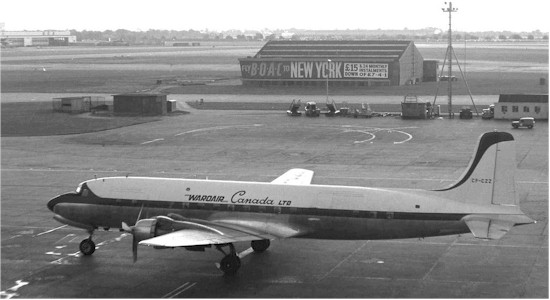|
Continuation of the DC-6 story started in NetLetter #1531 and 1532 -
Life with Wardair Wardair will need little introduction to readers. Its dynamic founder Max Ward built up a thriving bush operation based out of Yellowknife in Canada's Northwest Territories, with such types as the de Havilland Beaver and Otter and Bristol Freighter. He decided to diversify into operating passenger charters, and for this purpose Wardair took CF-CZZ on lease from Canadian Pacific.
Before its passenger work it was used from March 1962 onwards, during the late winter and early spring of that year, on a freight operation in the High Arctic under contract to the Polar Continental Shelf project. The main freighting operation was out of Resolute Bay to the weather stations at Isachsen, Eureka, Alert and Mould Bay as well as Thule Air Base in Greenland.
One of the stipulations of the lease contract was that Wardair would make the aircraft available to CPA if it was needed to help with the repair of any CPAL aircraft. Just such a requirement arose during April 1962 when a CPAL DC-8 went unserviceable in Honolulu and required an engine change. While CF-CZZ was busy freighting in the frozen wastes of the High Arctic, the call came that its services were needed in sunny Hawaii.
After two trips to Isachsen on Ellef Ringnes Island, CF-CZZ departed Resolute Bay on April 19, overnighted at Yellowknife, and then flew via Fort Smith and Edmonton to Vancouver.
The spare Rolls-Royce jet engine was loaded and flown to Honolulu, after which the crew "hit the beach" for the day, before returning to the frozen wastes of northern Canada, their job done.
When the freighting operation ended in the spring, Wardair commenced its programme of passenger charters with CF-CZZ. As Max Ward wrote in his autobiography: "Our first overseas charter came on June 22, 1962 when we took a group from Edmonton to Copenhagen with stops at Frobisher Bay and Prestwick. During that summer we completed eight overseas charters out of western Canada to the UK and Europe, and lost money on every one of them." One of these charters was to London, where CF-CZZ was noted at Heathrow on July 16 and 18, 1962.
Perhaps due to the harshness he himself had endured as a pilot in the bush, Max Ward was determined to treat his passengers well. He was the first to serve all passengers a filet steak on Royal Dalton bone china that was the hallmark of Wardair's renowned cabin service. CF-CZZ may have been "relegated" to a charter company, but it was still flying in considerable style.
When the summer charter season ended in September 1962, Wardair could not find any work for the DC-6, and so it returned the aircraft off lease to CPA, who made use of it that winter and for most of 1963. Grant McConachie, CPA's president, is reported to have said that he made more money leasing it to Wardair than he could have made flying it. In March 1963 Wardair bought a Douglas DC-6B from KLM to continue its charter programme, and this aircraft became CF-PCI. On September 6 1963 Wardair took another lease of CF-CZZ from CPA for an Arctic freight contract, but this work had barely started when disaster struck.
On September 15, 1963 CF-CZZ was on approach to Mould Bay, North West Territories, on a flight from Resolute Bay. The rear fuselage and tail hit a rock outcrop when white-out conditions were encountered, and an overshoot attempted. Four days later, CF-CZZ was ferried in its damaged state from Mould Bay via Edmonton to Vancouver, where it was returned off lease to CPA, who repaired the damage. That unfortunate incident brought an end to the aircraft's association with Wardair.
|
| CF-CZZ London-Heathrow circa 1963 Photo courtesy of Dave Welch |

